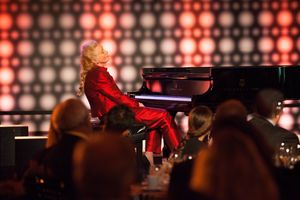 I just did a series of master classes with some young college students. These are always fun for me – the give and take, the exchange of ideas and always their concern for finding the right way to play the piano. Actually there is no “right” way- whatever works for your particular mechanism without causing harm is usually the best way to proceed.
I just did a series of master classes with some young college students. These are always fun for me – the give and take, the exchange of ideas and always their concern for finding the right way to play the piano. Actually there is no “right” way- whatever works for your particular mechanism without causing harm is usually the best way to proceed.
When I say “without causing harm” I mean without any sign of tension or forcing. At the first sign of tiredness, that is the signal for us to stop- that means that clearly something is not working properly and we might be doing something wrong and risk doing serious damage to our muscles. That’s when the alarm bells should sound off. Then we need to look at our hands and observe exactly what is in tension and then ask ourselves, how can we alleviate that tension?
Each of us is built differently and this is why we each have to find what works best for our particular body. A tall pianist like Van Cliburn needed a different way of approaching the instrument than Artur Rubinstein who was very short and compact. For Horowitz, it meant playing with flat fingers- that was his personal way of coloring and controlling the sound. For Liszt, the string breaker, the piano was attacked from on high truly making the most use of the force of gravity. For others, control is only attained by staying close to the keys. But the goal should always be the same -to play easily and comfortably and without tension. 
When I was a high school student in Philadelphia, my high school music teacher sent me to play for one of the most prominent piano teachers in the city – of course, she had to be good because all of her students won the Philadelphia Orchestra auditions and had the chance to solo with the orchestra at the children’s concerts. I must confess that at that time in my life, I knew nothing about piano technique- I naively thought that when one practiced, one would make progress and keep playing better and better, and I was enjoying studying the piano and discovering all this marvelous music written for the instrument. Our first lessons together were anything but enjoyable. I was told that I was doing everything wrong at the keyboard and it was necessary to start all over again with her “method” of playing the piano. So I dutifully took home the book of Pischna exercises that were assigned to me but had no understanding why these would make a difference in how to play the piano. Looking back, what I was doing as a young student was approaching the piano naturally, in a way that suited my physical build- I was fortunate that I had acquired some facility. The last thing I wanted to do was to start at square 1 all over again. My mother, seeing how upset these lessons made me decided wisely that this was not the right teacher for me. And so I moved on and found another teacher who did not want to tear down but wanted to add to the foundation that was already in place and make it better.
That is the attitude I have when I do guest master-class teaching. Whatever technical problem is visible can be solved with certain general principles- the most important one being to play everything without unnecessary tension. When the principles are known, students can adapt these to their own personal mechanism and create their personal approach to piano technique and build the foundation for good piano playing.
I was fortunate that when I was a college student, I found a teacher who could explain the principles of technique and add to what I was doing with only my fingers. This meant incorporating the wrist, the forearm, the upper arm, even using the back muscles to make use of the force of gravity. All these factors contribute to the pianist's individual sound- his personal “branding.” A wonderful example is Vladimir Horowitz- no one sounded like him when playing the Steinway. I remember trying his personal Steinway - to me, it was like a runaway piano but for Horowitz’s technique it was the perfect instrument to achieve the color and excitement he wanted as well as extraordinary fleeting passage work.
Playing the piano is not rocket science- sometimes, all we need to remember is good common sense. “No pain- no gain” does not apply to piano playing or to playing any instrument. What we need to find is a natural approach – a coordination of the whole body so it will be in harmony with the instrument. And after all the technical problems have been solved, then we can get down to the serious business of making music. That’s when the fun really begins!
-
0:00/7:07
-
0:00/10:28
-
0:00/11:47
-
0:00/3:55
-
0:00/2:51
-
0:00/5:20
-
0:00/1:17
-
0:00/2:16
-
0:00/7:19
-
0:00/2:37
-
0:00/3:51
